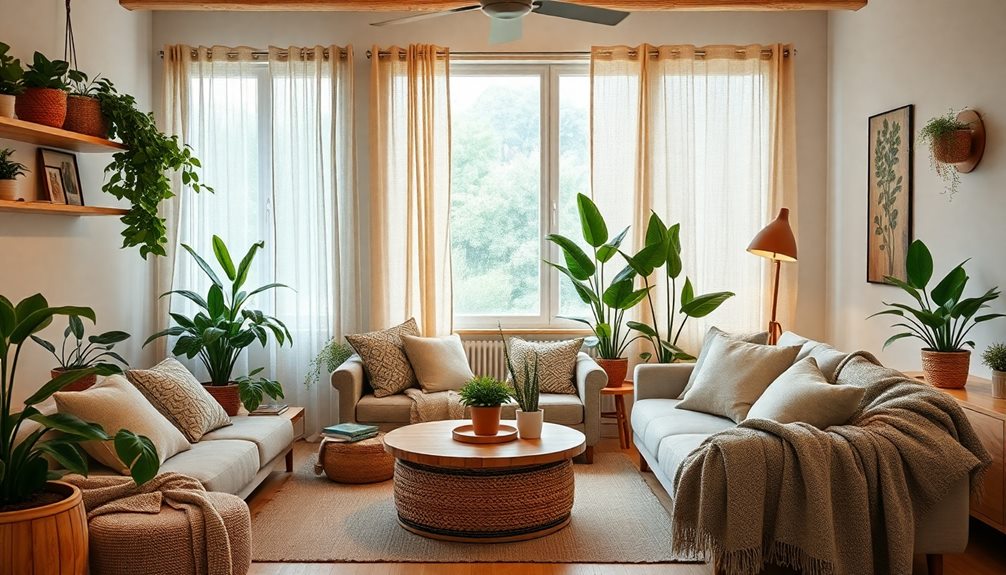Sustainable textiles can transform your home while reducing environmental impact. Opt for natural fibers like organic cotton, linen, hemp, and bamboo, which are biodegradable and require less water to produce. Look for certifications like GOTS and Oeko-Tex to guarantee eco-friendly practices. Linen stands out for its durability and unique texture, making it perfect for curtains and table settings. Hemp is another excellent choice, promoting soil health and biodiversity. By choosing these fabrics, you're contributing to a more sustainable future. If you want to discover more sustainable options and benefits, there's a lot more to explore!
Key Takeaways
- Sustainable textiles prioritize eco-friendliness and ethical labor practices, significantly reducing environmental impact in home decor.
- Key certifications like GOTS and Oeko-Tex ensure fabrics are produced responsibly and free from harmful substances.
- Popular natural fabrics include organic cotton, linen, hemp, bamboo, and Tencel, each offering unique benefits for home decor.
- Hemp and linen are particularly durable, breathable, and biodegradable, making them excellent choices for various applications in interior design.
- Animal-based materials like wool and silk can also be sustainable, provided they are sourced ethically and certified.
Understanding Sustainable Textiles
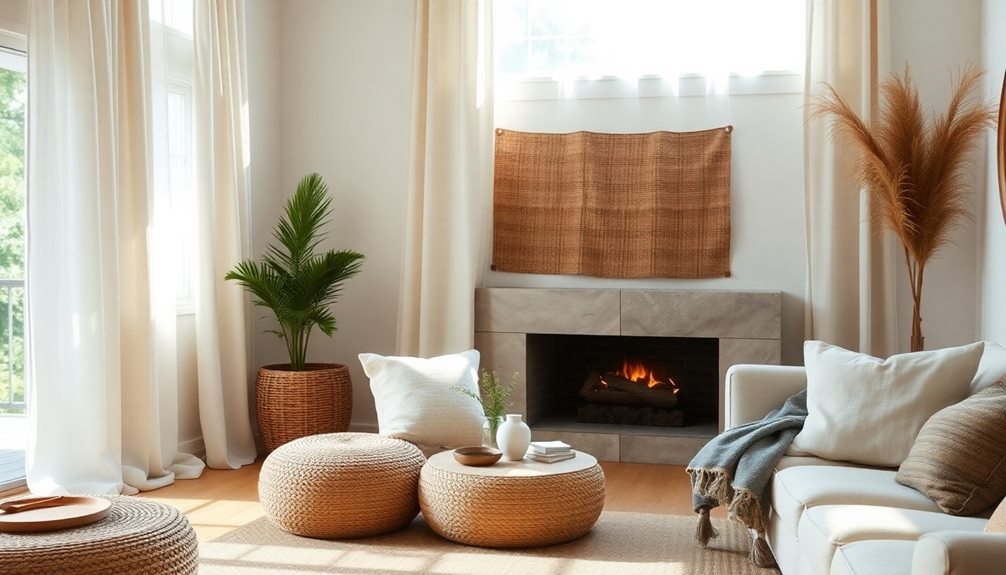
When you think about the fabrics in your home, consider how sustainable textiles can transform your decor and the environment. Sustainable fabrics are designed with eco-friendliness and ethical labor practices in mind, making them a responsible choice for your living space.
These textiles often come from natural fibers like organic cotton and linen, which are biodegradable and greatly reduce landfill waste compared to synthetic options.
Incorporating eco-friendly fabrics into your home not only enhances your decor but also helps lower your carbon footprint. The fashion and home decor industries contribute around 10% of global carbon emissions, so choosing sustainable textiles can make a positive impact.
You can also find man-made options like Tencel®, which are produced with sustainability in mind, as well as hybrid fabrics that blend natural and synthetic fibers.
When selecting sustainable fabrics, look for certifications that confirm their eco-friendly practices. Understanding the sourcing and production processes can help you make informed choices that benefit both your home and the planet.
Key Certifications for Eco-Friendly Fabrics
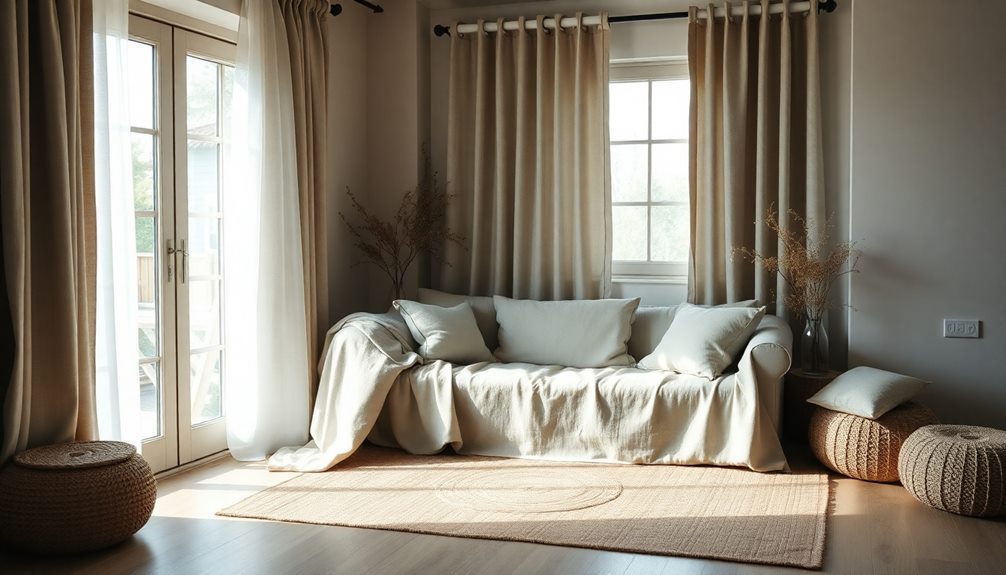
Choosing sustainable textiles means understanding the key certifications that guarantee eco-friendly practices. Familiarizing yourself with these certifications helps you make informed choices for your home decor.
| Certification | Description |
|---|---|
| Global Organic Textile Standard (GOTS) | Certifies organic fabrics, requiring at least 95% organic fibers for the "organic" label, assuring sustainable practices throughout the supply chain. |
| Oeko-Tex Standard 100 | Guarantees textiles are tested for over 100 harmful substances, ensuring non-toxic materials for consumer safety. |
| FSC Certification | Indicates that fabrics sourced from wood or plant-based materials come from responsibly managed forests that provide environmental, social, and economic benefits. |
Popular Natural Fabrics
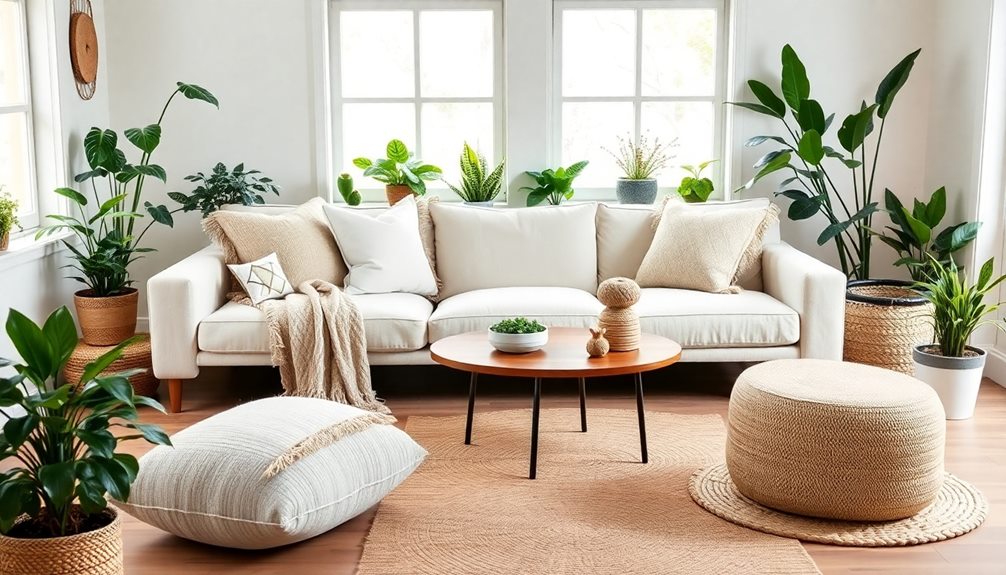
When it comes to choosing textiles for your home, natural fabrics offer a range of benefits that are hard to ignore.
From organic cotton to hemp and linen, each fabric type brings unique sustainable sourcing practices that can enhance your decor while being eco-friendly. These materials not only reduce environmental impact but also introduce timeless textures and charm to your space. Pairing them with upcycled items can create a cohesive, environmentally conscious design. For instance, incorporating thrifted furniture makeover tips allows you to breathe new life into pre-loved pieces, further emphasizing sustainability in your home decor.
Let's explore some popular natural fabrics and how they can make a difference in your living space.
Benefits of Natural Fabrics
Discovering the benefits of natural fabrics can transform your home decor while promoting sustainability. By choosing materials like organic cotton, linen, and hemp, you're not just enhancing your space but also making eco-friendly choices. These fabrics are biodegradable and derived from renewable resources, making them excellent sustainable materials.
Here's a quick comparison of popular natural fabrics:
| Fabric | Benefits |
|---|---|
| Organic Cotton | Grown without synthetic pesticides; reduces water consumption. |
| Linen | Strong, breathable; requires fewer resources. |
| Hemp | Minimal water and pesticides; durable and great insulation. |
| Bamboo | Naturally antibacterial; grows quickly and regeneratively. |
| Tencel | Made from sustainably sourced wood; soft and biodegradable. |
When you incorporate these natural fabrics into your home, you also improve indoor air quality. They don't contain harmful chemicals found in synthetic materials, creating a safer environment for you and your family. Ultimately, opting for natural fabric enhances the aesthetic of your home while supporting a healthier planet.
Sustainable Sourcing Practices
Natural fabrics not only enhance your home decor but also pave the way for sustainable sourcing practices that benefit the environment. When you choose organic cotton, you're supporting a farming method that avoids synthetic pesticides and fertilizers, promoting biodiversity and conserving water.
Additionally, the vibrant colors and intricate designs found in traditional textiles, such as those from Bengal, reflect rich cultural narratives that can complement contemporary décor urban imagery in art.
Linen, derived from flax plants, is another eco-friendly option. It requires fewer resources than cotton and boasts incredible strength and breathability.
Hemp deserves a mention as well, being one of the most sustainable fabrics available. It thrives with minimal water and pesticides, making it a durable choice for various applications.
Then there's Tencel® (Lyocell), produced from sustainably sourced wood pulp through a closed-loop system. This eco-friendly process not only minimizes environmental impact but also results in a soft, biodegradable fabric perfect for home textiles.
Popular Natural Fabric Types
A variety of popular natural fabrics can transform your home decor while promoting sustainability.
First up is organic cotton, which is grown without synthetic pesticides or fertilizers, making it a favorite for eco-conscious homeowners. Its softness and versatility fit perfectly into any space.
Hemp is another sustainable option; it requires minimal water and pesticides, offering incredible durability and breathability, ideal for everything from curtains to upholstery.
Linen, made from the flax plant, boasts moisture-wicking properties and strength, needing less water and fewer pesticides than conventional cotton. It's perfect for summer textiles like tablecloths and bed linens.
Recycled polyester stands out as well, created from post-consumer plastic bottles. It helps divert waste from landfills while delivering durability and quick-drying benefits.
Bamboo Fabric and Its Benefits
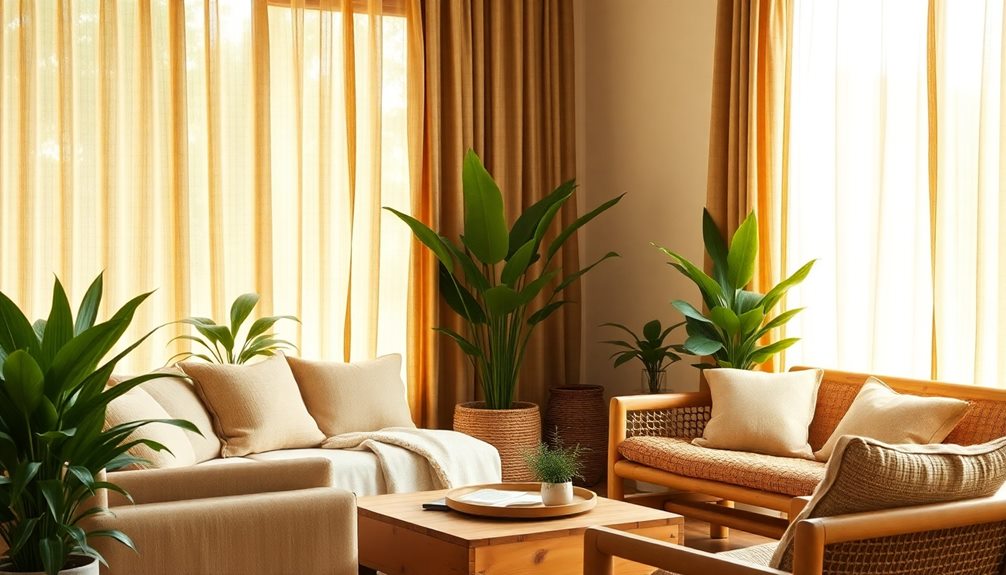
Bamboo fabric stands out as a remarkable eco-friendly option for home decor, thanks to its rapid growth and minimal resource requirements. This sustainable textile is derived from one of the fastest-growing grasses on the planet, needing no pesticides, fertilizers, or additional irrigation during its cultivation.
However, it's vital to guarantee that bamboo is sourced sustainably; otherwise, clearing land for plantations can lead to biodiversity loss.
When choosing bamboo fabric, look for options that are mechanically processed rather than chemically treated. This method maintains the sustainability of the fabric and reduces its environmental impact.
To further enhance your eco-friendly choices, consider bamboo certified by the Forest Stewardship Council (FSC), which promotes responsible forestry practices.
Not only is bamboo fabric a sustainable choice, but it also offers practical benefits. Its natural antibacterial properties make it an excellent option for home textiles, while its moisture-wicking and breathable qualities provide comfort in clothing.
Advantages of Hemp Textiles
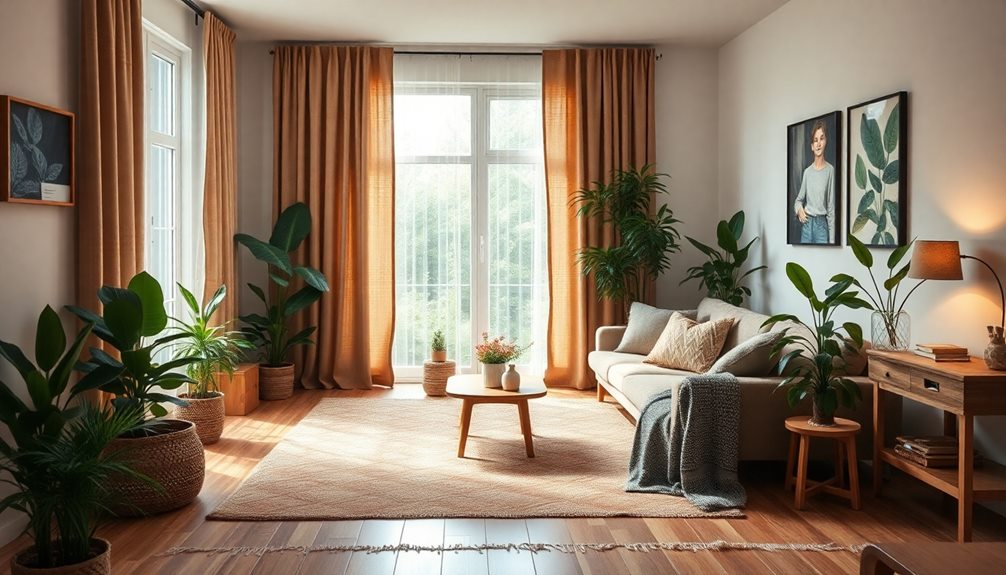
When it comes to sustainable textiles, hemp fabrics stand out for their impressive eco-friendliness and versatility. You'll appreciate knowing that hemp is derived from the cannabis plant and requires minimal water and pesticides, making it an environmentally friendly choice for your home decor.
Beyond its low-impact growth, hemp cultivation promotes biodiversity and improves soil health, thanks to its deep root system that prevents soil erosion.
One of the most significant advantages of hemp textiles is their durability. Hemp fabric is known for lasting longer than conventional cotton, ensuring that your investment in home decor remains intact for years to come. This means fewer replacements and less waste in landfills.
Additionally, hemp textiles boast excellent breathability and insulating properties, making them suitable for various applications, from curtains to upholstery.
You can also feel good knowing that hemp can be processed into biodegradable fabrics, contributing to a more sustainable lifecycle compared to synthetic alternatives.
The Role of Organic Cotton
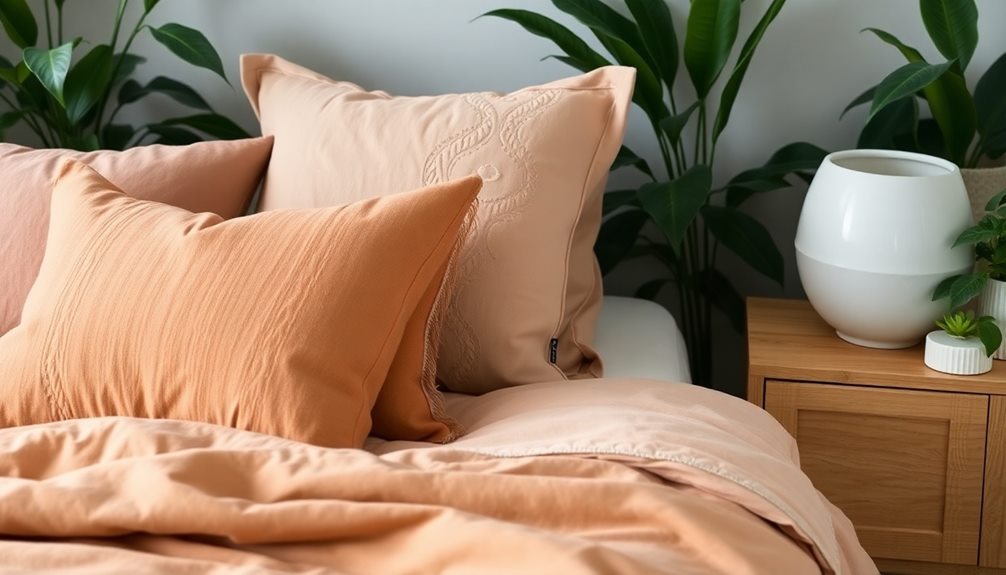
Often overlooked in discussions about sustainable textiles, organic cotton plays an essential role in eco-friendly home decor. By avoiding synthetic pesticides and fertilizers, organic cotton supports biodiversity and minimizes chemical runoff into ecosystems. This approach not only benefits the environment but also enhances the quality of the cotton itself.
When it comes to resource usage, organic cotton farming is a sustainable choice. It utilizes approximately 88% less water than conventional cotton, making it a more efficient option for your home textiles. You'll find that organic cotton is soft, breathable, and hypoallergenic, creating a comfortable atmosphere without the harmful chemicals often found in conventional textiles.
Despite these benefits, only 1% of the world's cotton production is organic, which underscores the importance of increasing consumer demand for environmentally friendly options. By choosing organic cotton products, you're not just enhancing your home decor; you're also supporting sustainable practices.
To guarantee that you're selecting high-quality organic cotton, look for certifications like Global Organic Textile Standards (GOTS), which require at least 95% of fibers in a product to be organic. This guarantees transparency in sourcing and production practices, making your choice even more impactful.
Exploring Linen and Its Uses
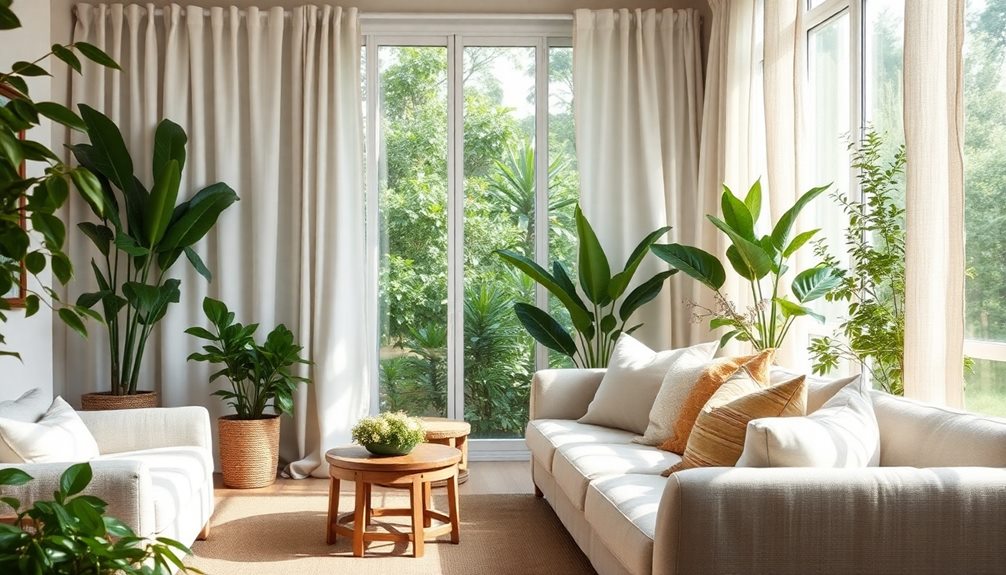
When you choose linen for your home decor, you're opting for a fabric that's not only strong and breathable but also eco-friendly.
Its unique properties, like moisture-wicking and durability, make it perfect for various applications in your space.
However, you'll need to keep in mind some care tips to maintain its quality, especially in humid environments.
Linen Fabric Characteristics
Linen fabric stands out as a versatile choice for home decor, thanks to its unique characteristics. Made from the flax plant, linen's production process is eco-friendly and sustainable, requiring considerably fewer pesticides and water than conventional cotton. This means you can feel good about choosing linen for your home.
Here are some key characteristics of linen fabric:
- Durability: Linen is known for its strength, making it a long-lasting option for upholstery and drapery.
- Breathability: Its breathable and moisture-wicking properties guarantee comfort, especially in warm weather, making it perfect for summer textiles.
- Natural Aesthetic: Linen has a lovely natural luster and crisp texture, enhancing the look of any decor style, from rustic to contemporary.
Additionally, linen's resistance to fading and sun damage allows it to maintain its beauty both indoors and outdoors.
By opting for linen, you're not just choosing a fabric; you're supporting sustainable practices that benefit the environment.
Benefits of Linen
As you explore the possibilities for home decor, the benefits of linen become even more apparent. This fabric, derived from the flax plant, stands out as an eco-friendly choice, requiring far fewer pesticides and less water than conventional cotton.
Its durability is another significant advantage; linen can withstand the wear and tear of daily life, making it perfect for upholstery and drapery that see regular use.
Linen's natural moisture-wicking properties and breathability provide comfort, especially in warm weather. This makes it a popular option not just for home textiles but also for summer clothing.
Beyond functionality, linen boasts a unique texture and drapes beautifully, allowing you to create elegant table settings and stylish curtains that elevate your space.
Importantly, linen is biodegradable, contributing to sustainable living. When it reaches the end of its life cycle, it decomposes naturally, reducing your environmental impact compared to synthetic fabrics.
Linen Care Tips
To keep your linen looking its best, proper care is essential. Linen is a sustainable option made from the flax plant, requiring fewer pesticides and less water than conventional cotton. Its strength and durability make it perfect for drapery, upholstery, and bedding, but you'll want to follow these care tips to maintain its natural beauty:
- Wash in cold water: Avoid using bleach, as it weakens the fibers and affects texture.
- Iron while damp: This helps remove wrinkles effectively without damaging the fabric. A steamer works great, too!
- Embrace the wrinkles: Linen has a natural tendency to wrinkle, adding to its charm and relaxed aesthetic.
In addition to its durability, linen is breathable and moisture-wicking, making it comfortable for warm climates.
Animal-Based Materials Considerations
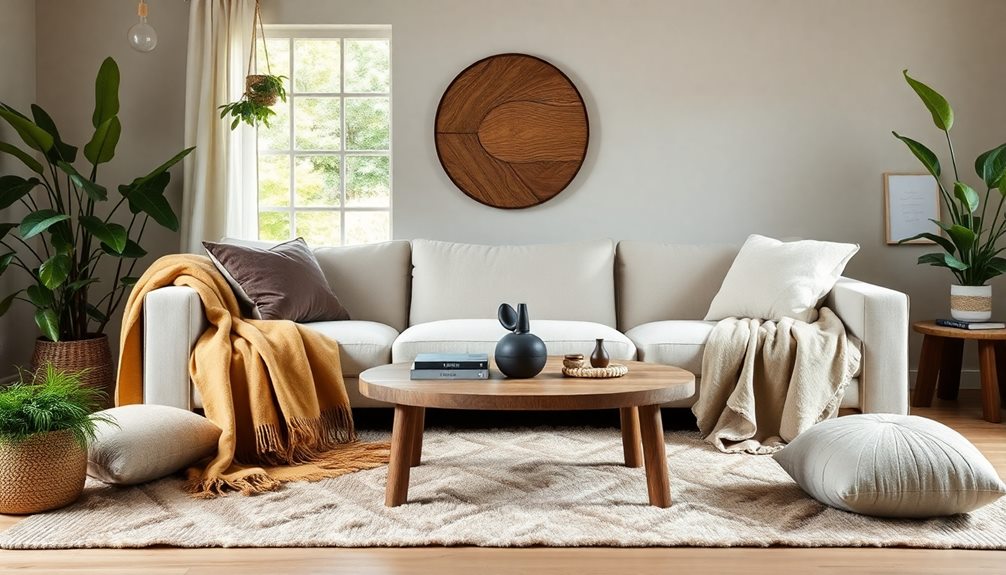
Considering animal-based materials for your home decor can significantly impact both sustainability and ethical practices. While materials like wool and down are durable and biodegradable, it's essential to contemplate their sourcing. Responsible farming practices can make a substantial difference in animal welfare and environmental impact.
Here's a quick overview of key animal-based materials:
| Material | Benefits | Certifications |
|---|---|---|
| Wool | Natural moisture-wicking, biodegradable | Cruelty-free, RWS |
| Down | Insulation, lightweight | Responsible Down Standard |
| Silk | Luxurious feel, biodegradable | Fair Trade |
| Leather | Durable, recyclable | Sustainable Leather |
| Alpaca | Softness, hypoallergenic | Ethical Alpaca |
When choosing these materials, look for certifications that guarantee ethical treatment. The Responsible Down Standard (RDS) ensures humane sourcing of down, while cruelty-free labels help identify products that prioritize animal welfare. By being conscious of your choices, you can promote ethical consumption and contribute to a more sustainable home decor environment.
Impact of Semi-Synthetic Fabrics
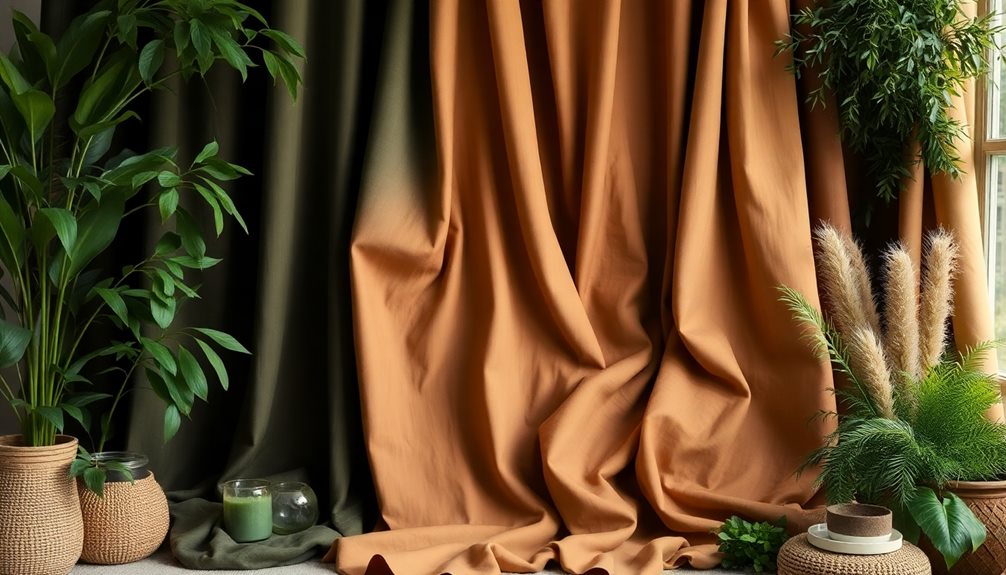
When you consider semi-synthetic fabrics like Tencel®, you'll find their eco-friendly production methods stand out.
These materials not only biodegrade but also offer significant recycling potential, making them a smart choice for sustainability.
Eco-Friendly Production Methods
Eco-friendly production methods are transforming the textile industry, particularly with the rise of semi-synthetic fabrics like Tencel®.
These fabrics, made from sustainably sourced wood pulp, utilize a closed-loop process that recycles water and solvents, greatly minimizing environmental impact.
Compared to conventional synthetic fibers, semi-synthetic options typically consume fewer resources and emit lower greenhouse gases.
When you choose semi-synthetic fabrics, you're making a more sustainable choice for your home decor.
Consider these benefits:
- Resource Efficiency: Tencel® requires about 50% less water to produce than cotton, promoting water conservation in textile manufacturing.
- Lower Emissions: The production of semi-synthetic fabrics generates fewer greenhouse gases than traditional synthetic options, like recycled polyester, which often relies on petroleum.
- Biodegradability: Tencel® decomposes naturally at the end of its life cycle, reducing landfill waste and contributing to a circular economy.
Biodegradability and Recycling Potential
Biodegradability and recycling potential are key aspects of semi-synthetic fabrics like Tencel®. These materials are derived from sustainably sourced wood pulp and are fully biodegradable, making them an eco-friendly choice for your home decor.
Unlike traditional synthetic fabrics that can linger in landfills for hundreds of years, Tencel® breaks down much more quickly in natural environments, reducing its environmental impact.
Montessori Toys emphasize natural materials that align with sustainable practices, reinforcing the importance of eco-conscious choices in various aspects of life.
The closed-loop manufacturing process of Tencel® not only minimizes waste but also uses considerably less water than cotton production. This contributes to its sustainability credentials, allowing you to feel good about your choices.
However, when it comes to recycling potential, the situation is a bit more complex. While Tencel® can be recycled into new fibers, the infrastructure for recycling such materials is still developing.
This means that while you can support eco-friendly practices by selecting semi-synthetic fabrics, widespread adoption of recycling solutions is still a work in progress.
Incorporating Tencel® into your home decor not only enhances the aesthetic but also supports sustainable forestry practices, making it a responsible and stylish choice.
Sustainable Practices in Fabric Production
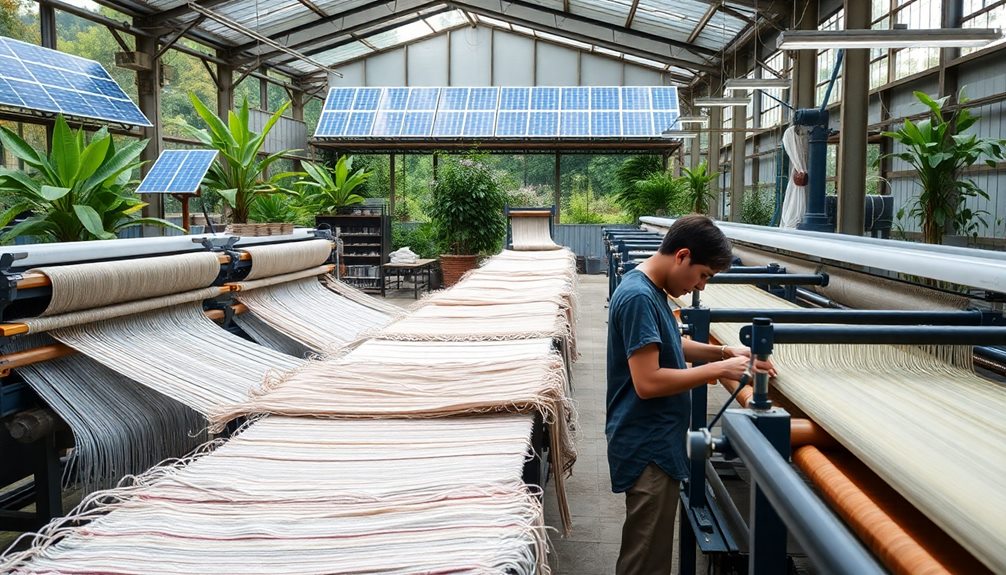
Sustainable practices in fabric production are gaining traction as more consumers seek environmentally responsible options for their home decor. By focusing on renewable, recycled, and eco-friendly materials, producers are minimizing the environmental impact throughout the lifecycle of textiles.
These practices help combat the negative effects of fast fashion while promoting transparency in sourcing.
Here are some key aspects of sustainable fabric production:
- Certifications: Look for textiles verified by standards like GOTS and Oeko-Tex Standard 100, ensuring environmentally and socially responsible production.
- Water Efficiency: With cotton requiring over 20,000 liters for just one kilogram, adopting water-efficient practices is critical in reducing resource consumption.
- Innovative Processes: Techniques like the closed-loop system in Tencel® production exemplify how modern methods can align with sustainability goals, reducing waste and harmful emissions.
Frequently Asked Questions
How Can I Identify Sustainable Textiles in Stores?
To identify sustainable textiles in stores, look for certifications like GOTS or OEKO-TEX. Check labels for organic materials, and ask sales staff about production practices. You're supporting eco-friendly options by making informed choices.
Are Sustainable Textiles More Expensive Than Conventional Fabrics?
Sustainable textiles often cost more than conventional fabrics due to higher production standards and eco-friendly materials. However, investing in them supports ethical practices and can lead to better durability and longevity for your purchases.
Can Sustainable Fabrics Be Washed and Cared for Like Regular Textiles?
Yes, you can wash and care for sustainable fabrics just like regular textiles. Most are machine-washable and durable, so follow the care instructions, and you'll keep them looking great without any hassle.
What Are the Environmental Benefits of Using Sustainable Textiles?
Imagine a world where every fabric choice nurtures the Earth. By choosing sustainable textiles, you reduce waste, conserve resources, and support ethical practices. You're weaving a brighter future, one eco-friendly thread at a time.
Are There Any Synthetic Sustainable Fabrics Available?
Yes, there are synthetic sustainable fabrics available. You'll find options like recycled polyester and nylon, which reduce waste and energy consumption. These materials can provide durability while still being environmentally friendly in your projects.
Conclusion
In a world where your choices weave the fabric of a sustainable future, opting for eco-friendly textiles isn't just a trend—it's a commitment. By embracing natural and responsibly produced materials, you're not just decorating your home; you're nurturing the planet. Each sustainable fabric adds a thread of hope, creating a tapestry that reflects both style and conscience. So, let your decor speak volumes about your values, turning your space into a sanctuary of sustainability.
